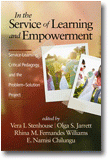
In the Service of Learning and Empowerment
Service-Learning, Critical Pedagogy, and the Problem-Solution Project
By:
Vera L Stenhouse, Georgia State University
Olga S. Jarrett, Georgia State University
Rhina M. Fernandes Williams, Georgia State University
E. Namisi Chilungu, Georgia State University
Published 2014
Too often teachers and students doubt their own abilities to forge collective work and dynamic critical learning in the midst of education reform practices that limit their opportunities to do so. This doubt can be heightened for elementary school teachers or even their students who are led to believe that they are not capable of engaging critically with their education and their world. The Problem-Solution Project erases this doubt through merging service-learning, critical pedagogy, and constructivism. This approach to teaching and learning is designed to empower teachers and students while they meet curriculum standards and actively contribute to the transformation of their world.
Unique to this collection are the reported experiences of teacher educators who implement Problem-Solution Projects in their courses; preservice teachers’ reflections on cohort-driven Problem-Solution Projects; and first-year and veteran teachers stories featuring Problem-Solution Projects initiated by their PK-5 students.
Features include:
• Describes how Problem-Solution Projects advance service-learning and critical pedagogy.
• Discussion of how Problem-Solution Projects build on curriculum standards but resists standardization of implementation and repressive education reforms.
• First-hand accounts of teachers implementing Problem-Solution Projects.
• Detailed description of the steps and outcomes of doing Problem-Solution Projects with preservice teachers, inservice teachers, and elementary students.
• Examples of Problem-Solution Projects across courses, subjects, disciplines, and contexts.
Readers will find worthwhile the theoretical connections and the practical applications. Service-learning, urban education, multicultural education and teacher education, teacher preparation practitioners will find this text beneficial. The main audience: teacher educators across disciplines, pre- and in-service teachers working in elementary (PK-5) settings.
CONTENTS
Acknowledgements. Foreword. Introduction. PART I: Fostering Empowerment through Service-Learning, Critical Pedagogy, Constructivism and the Problem–Solution Project. The Problem–Solution Project: Philosophical Roots and Influences. PART II: The Problem–Solution Project Assignment with Inservice Teachers and Their Pre-K to 5th Grade Students. The Problem–Solution Assignment with Newly Certified Teachers. “When I First Began To Teach It”: Reflection on Inheriting the
Problem–Solution Project Assignment, Namisi’s Story. The Problem–Solution Project Assignment with Veteran Teachers, Rhina’s Story. PART III: Voices of Inservice Teachers Engaged in Problem–Solution Projects with Pre-K–5th Grade Students. “Aren’t They Too Young to Do a Problem–Solution Project?”: Underestimating the Ability of Young Children to Solve Problems. “ What Are We Going to Do About It?”: Fostering Agency Through Language. “ They Came to School Early to Work on the Project”: School as a Place to Be, Education as Worthwhile. “It’s OK to Help Oneself”: Self-Help, Self-Empowerment. “They See a Lot of What Is Wrong”: Direct Community Connections. “ I Let the Students Take Control”: Student-Centered, Student-Driven, Enhanced Learning. “ I Could Not Ignore Their Desire to Solve a Challenge”: Teachers as Central to the Solution. “ I Met So Many of the Required Standards”: Engaged Learning as Meeting Standards Not Standardizing Instruction. “Students Made the Mess and Should Have to Live with the Consequences”: Encountering Resistance, Countering with Persistence. “Doing the Problem–Solution Project Has Greatly Influenced the Way I Teach”: Beyond the Requirement of Doing the Problem–Solution Project. Advice, Guidance, and Insights: Inservice Teachers’ Insights on Implementing the Problem–Solution Project. PART IV: THE PRESERVICE TEACHER COHORT EXPERIENCE. The Problem–Solution Project Assignment with Preservice Teachers. Cultivating an Empowering Education and the Salience of Power: Challenges, Tensions and Lessons Learned. Instructors’ Perspectives on Implementing Problem–Solution Projects with Preservice Teachers: A Dialogue. PART V: THE PROBLEM–SOLUTION PROJECT AND AN EMPOWERING EDUCATION: IMPLICATIONS. An Empowering Education and the Problem–Solution Project. Considerations for Practice, Policy, Teacher Education, and Teacher Preparation.References. A Shor’s Characteristics of an Empowering Education. B Problem–Solution Project (Newly Certified Inservice Teachers) Masters. C Problem–Solution Project (Veteran Inservice Teachers) Education Specialist Problem–Solution Project. D Problem–Solution Project Teacher Contributors. E Problem–Solution Project Teacher Questionnaire. F Problem–Solution Project (Preservice Teachers). G Interstate New Teacher Assessment and Support Consortium (INTASC) Standards. H Inservice Teachers (Year II) Final Reflection Prompts.
-
Paperback9781623965440
Web price: $45.04 (Reg. 52.99)
-
Hardcover9781623965457
Web price: $80.74 (Reg. 94.99)
- eBook9781623965464

- EDU000000 - EDUCATION: General
- EDU008000 - EDUCATION: Decision-Making & Problem Solving
- EDU037000 - EDUCATION: Research
-
 (Re)Envisioning Social Studies Education Research
Current Epistemological and Methodological Expansions, Deconstructions, and Creations
(Re)Envisioning Social Studies Education Research
Current Epistemological and Methodological Expansions, Deconstructions, and Creations
-
 American Educational History Journal - Golden Anniversary Edition
Volume 50 Numbers 1 & 2
American Educational History Journal - Golden Anniversary Edition
Volume 50 Numbers 1 & 2
-
 Distance Learning
Volume 20 #3
Distance Learning
Volume 20 #3
-
 Distance Learning
Volume 20 #4
Distance Learning
Volume 20 #4
-
 Qualitative Research With Diverse and Underserved Communities
Qualitative Research With Diverse and Underserved Communities
-
 Quarterly Review of Distance Education
Volume 24 #1
Quarterly Review of Distance Education
Volume 24 #1
-
 Rekindling Embers of the Soul
An Examination of Spirituality Issues Relating to Teacher Education
Rekindling Embers of the Soul
An Examination of Spirituality Issues Relating to Teacher Education

